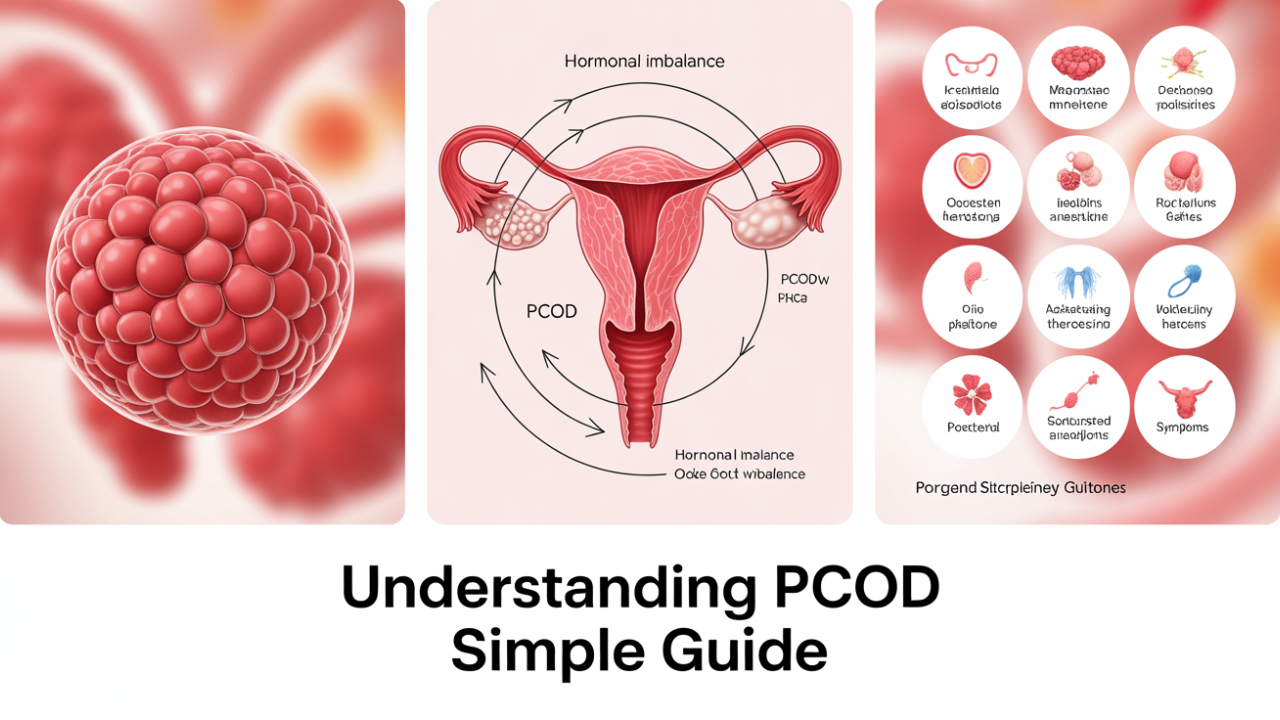
We all have moments when our bodies feel off—missed periods, sudden weight gain, breakouts that just won’t go away. For many women, these changes are brushed off as “just hormones.” But sometimes, they’re a sign of something more. One of the most common conditions behind these symptoms is PCOD. The Full form of PCOD is Polycystic Ovarian Disease—and it affects more women than we realize.
Let’s talk about it. No jargon, no judgment—just facts and support.
Let’s start with the basics. The full form of P C O D is Polycystic Ovarian Disease. It’s a condition where a woman’s ovaries start producing more eggs than necessary, but most of these eggs don’t fully mature. Instead, they stay inside the ovaries as tiny cysts. Over time, this affects the balance of hormones in the body.
And when hormones are out of balance, a lot of things—periods, skin, weight, mood—can get out of sync.
PCOD isn’t just about your periods. It can impact different parts of your life and health. Every woman’s experience is a little different, but here are some common things women with PCOD face:
It’s a long list, and the symptoms can be frustrating. But knowing what’s happening in your body is the first step toward feeling better.
There’s no one single cause of PCOD. It often comes down to a mix of factors:
PCOD isn’t something you caused, and it’s not something to be ashamed of. It just means your body needs a little more support right now.
If you’re dealing with the symptoms we mentioned earlier, it’s a good idea to get checked. PCOD isn’t diagnosed through one single test. It usually involves a combination of hormone blood tests and an ultrasound.
At RML Pathology, we offer:
As one of the best pathology labs forwomen’s health tests in Lucknow, we’re here to make the process comfortable, accurate, and trustworthy.
There’s no “quick fix” for PCOD—but the good news is, it can be managed with a few consistent steps. Many women see big improvements with simple lifestyle changes and medical advice.
Here’s what can help:
We also offer a special women’s health package at RML Pathology designed to detect issues like PCOD early—because early awareness means better control.
PCOD might not be visible on the outside, but it can affect everything from your energy to your confidence. The sooner you get tested and understand your body, the sooner you can feel in control again.
If something doesn’t feel right—your skin, your mood, your cycle—don’t wait. Trust your gut, and talk to someone. At RML Pathology, we’re here to help you figure it out, without judgment or confusion.
The full form of P C O D is Polycystic Ovarian Disease. It’s a hormonal condition where the ovaries develop multiple small cysts, affecting a woman’s menstrual cycle, skin, weight, and fertility.
Common symptoms of PCOD include irregular periods, weight gain, acne, excessive facial or body hair, hair thinning, mood swings, and difficulty in conceiving. Some women may have mild symptoms, while others may experience more severe changes.
The causes of PCOD in females can include genetic factors, insulin resistance, hormonal imbalance, stress, and poor lifestyle habits. While there’s no single cause, a combination of these factors usually plays a role.
The diagnosis of PCOD typically involves a set of hormone blood tests and an ultrasound of the ovaries. At RML Pathology, we offer a comprehensive women hormone profile and PCOD blood tests to help detect the condition accurately.
A PCOD blood test checks hormone levels like LH, FSH, testosterone, insulin, and prolactin. These tests help assess hormonal imbalance and are crucial for diagnosing PCOD.
Hormonal imbalance in women can lead to irregular periods, acne, mood swings, hair loss, fatigue, and fertility problems. In conditions like PCOD, these imbalances are often long-term but manageable with proper care.
Yes, irregular periods and PCOD often go hand in hand. If you frequently skip periods or have inconsistent cycles, it may be a sign of hormonal disruption caused by PCOD.
RML Pathology is considered one of the best pathology labs for women’s health tests in Lucknow, offering accurate PCOD testing, hormone profiling, and personalized health packages for women.
The RML Pathology women health package includes essential blood tests such as hormone levels, thyroid function, blood sugar, and other screenings to detect early signs of PCOD and related issues. It’s designed to provide a complete overview of your reproductive and general health.
There is no permanent cure for PCOD, but it can be managed effectively through lifestyle changes, medical treatment, and regular monitoring. Early diagnosis plays a big role in long-term management.
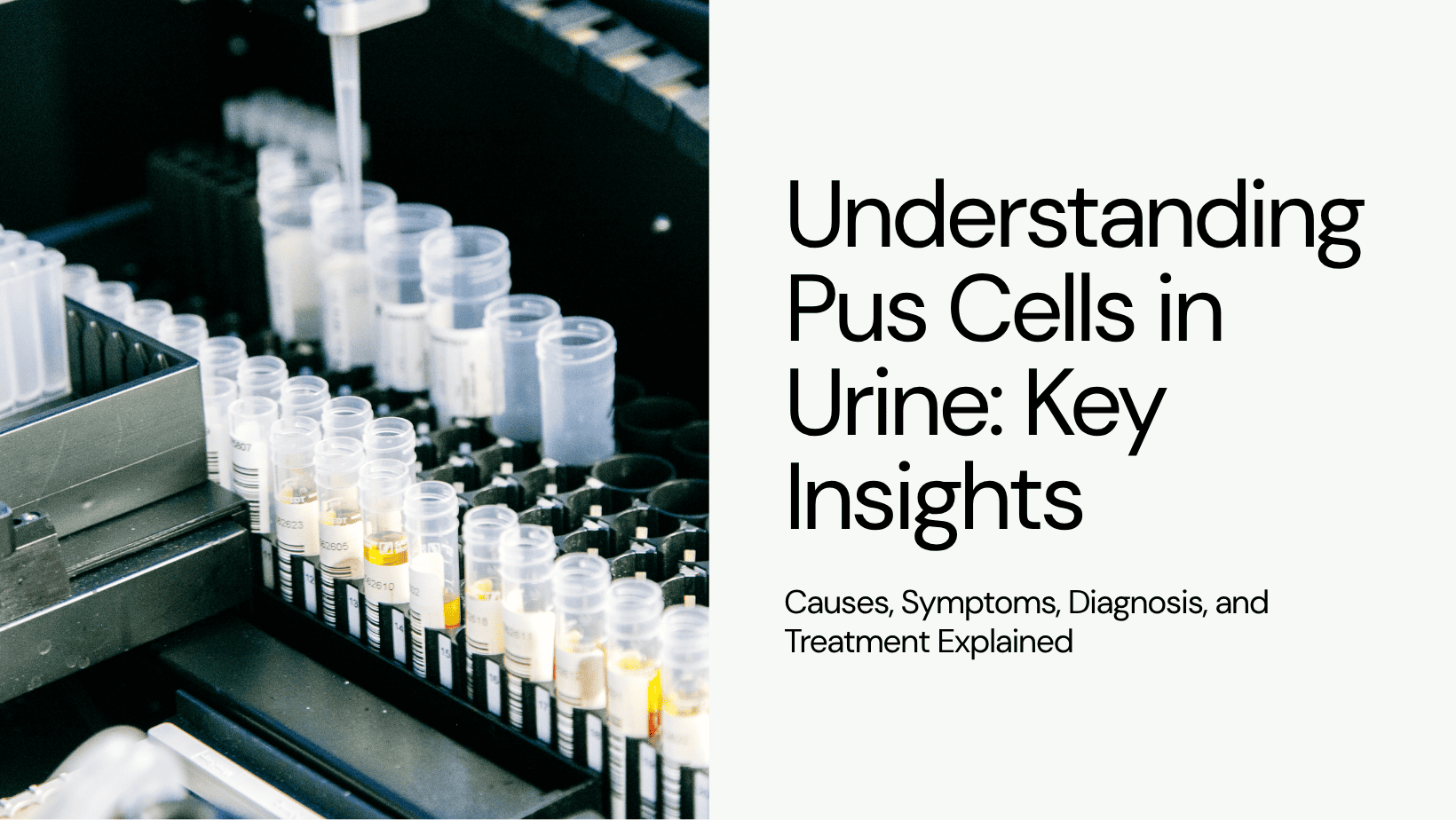
You went for a regular urine test, probably didn’t think much of it — until the report came back with the words: “pus cells in urine.” Sounds worrying, right? But here’s the truth: it’s more common than you think, and in many cases, it’s treatable. Still, it’s not something to ignore either.
This article will walk you through exactly what pus cells in urine means, what causes them, how they’re diagnosed, and what you can do about it — explained in a clear, no-jargon way.
Pus cells are white blood cells (WBCs) that help your body fight infections. When they’re found in your urine, it usually means your immune system is responding to something going wrong in your urinary tract — like an infection or inflammation.
This condition is medically known as pyuria.
In small numbers, pus cells in urine can be harmless. But a high count? That often means there’s a bigger issue that needs your attention.
Here’s what’s considered normal when a urine sample is viewed under a microscope:
Anything above these numbers is considered abnormal and should be investigated further.
There are several reasons why pus cells might show up in your urine. Some are minor, some more serious. Let’s look at the most common causes:
By far the most common reason. Bacteria enter the urinary tract and cause an infection. Your immune system sends WBCs to fight it — some end up in your urine.
A UTI that travels up to your kidneys can lead to a more serious infection.
You might experience:
STIs like gonorrhea or chlamydia can cause urethral inflammation, leading to pus cells even if you don’t feel classic UTI symptoms.
Stones can cause blockages or irritation, which leads to inflammation and sometimes infection — both of which can result in pus cells showing up in your urine.
Inflammation of the prostate can cause symptoms like pelvic pain, painful urination, and white blood cells in urine.
A rare but serious cause. TB can affect the kidneys and cause chronic pyuria with no bacteria in the urine (called sterile pyuria).
Diseases like lupus or interstitial nephritis can cause the immune system to attack the kidneys, leading to pus cells in the urine without any infection.
Not everyone with pus cells in urine will have obvious symptoms. But if the cause is an infection or inflammation, you might notice:
If you’re feeling any of these, don’t brush it off. They’re your body’s way of telling you something needs attention.
If pus cells show up in your urine, your doctor may recommend further tests to understand what’s going on.
This checks for:
A lab technician examines the urine under a microscope to count the exact number of pus cells and check for bacteria.
If a UTI is suspected, this test identifies the exact bacteria causing it and helps select the right antibiotic.
An ultrasound or CT scan might be needed to rule out kidney stones, abscesses, or structural problems.
Depending on your symptoms, additional tests may be ordered to rule out infections or autoimmune conditions.
The treatment depends entirely on the underlying cause. Once the issue is identified, here’s how it’s usually managed:
For UTIs, kidney infections, and most bacterial causes, antibiotics are the go-to treatment. Your doctor will choose one based on your urine culture results.
Drinking lots of water helps flush out bacteria and keeps your urinary system working properly.
If you’re in pain, over-the-counter painkillers like ibuprofen can ease discomfort while treatment takes effect.
Autoimmune diseases may require steroids or immunosuppressants
It’s a good idea to seek medical help if you experience any of the following:
Don’t wait — early treatment prevents serious complications, especially if your kidneys are involved.
You can reduce your risk of urinary issues with some simple daily habits:
Manage chronic illnesses like diabetes, which can raise infection risk
Pus cells in urine are a clue — not a diagnosis by themselves. They simply mean your immune system is active in your urinary tract. Sometimes it’s just a mild infection. Other times, it points to something more complex.
The key is not to ignore your symptoms or brush off a strange test result. If you notice discomfort, changes in your urine, or keep getting infections, talk to your doctor.
Health doesn’t come from luck — it comes from listening to your body.

Ever feel like no matter how much you rest, you’re still tired? Or maybe your bones ache, you catch colds too often, or your mood feels off for no clear reason. Get Vitamin d3 test to detect all weakness reasons.
It’s easy to blame it on a busy lifestyle, stress, or lack of sleep—but sometimes, it’s something as simple as Vitamin D deficiency.
Yes, the “sunshine vitamin” that your body makes when exposed to sunlight plays a much bigger role in your health than most people realize. And if you’re wondering whether you’re low, getting tested is simple—and the vitamin D3 test price is surprisingly affordable today.
Vitamin D isn’t just another item on your supplement list—it’s a nutrient your body needs for some major behind-the-scenes work.
It helps your body:
Pretty important, right? And the best part? Your body can make it naturally—with sunlight.
There are two main types:
D3 is the more powerful one. It lasts longer in your system and is more effective at raising your overall Vitamin D levels. That’s why doctors prefer to test and treat using Vitamin D3.
The tricky part is, Vitamin D deficiency symptoms don’t always hit you hard. They show up slowly and can be easily brushed off.
Some common signs include:
If you nodded at more than a couple of these, it might be time to get tested.
Here’s the surprising part: almost anyone can be deficient, even young and otherwise healthy people.
You’re more likely to have low Vitamin D if:
You have any liver, kidney, or gut conditions affecting nutrient absorption
Good news—you have options!
A simple test can tell you whether you’re low—and that clarity can make all the difference. Many people take unnecessary supplements or miss a diagnosis just because they never got tested.
By checking your Vitamin D level, you can:
Feel more energized, mentally clear, and physically strong
At RML Pathology, the process is easy and stress-free.
Results are shared online, on WhatsApp, or by email
We get it—health tests should be reliable and budget-friendly. That’s why RML Pathology offers an affordable vitamin D3 test price, so that you can stay on top of your health without worrying about cost. Check with your nearest RML center or visit our website for exact pricing.
You can also book full body packages that include Vitamin D—great value if you want a complete health check-up.
With RML Pathology, you’re choosing:
Whether it’s your first test or part of a routine check-up, we’ve got your back.
Vitamin D might not be the first thing you think of when you feel tired, moody, or weak—but it should be.
Getting tested is quick, easy, and affordable—and it can bring real improvement to how you feel every day.
With reliable results, expert care, and a reasonable vitamin d3 test price, RML Pathology is here to make your health journey simple.
Ready to check your levels? Book your Vitamin D3 test with RML Pathology today.
Your body will thank you.
You want to be between 20–50 ng/mL.
Once a year is fine for most people. If you’re at risk or on supplements, ask your doctor.
Yes! These are surprisingly common signs, especially in women.
Not at all—it’s a quick and simple blood draw.
At RML Pathology, you’ll get your report in 24 to 48 hours.
Our prices are very reasonable. Contact us or check our site for the latest vitamin d3 test price in your area.
It’s best not to. High doses without testing can lead to Vitamin D toxicity.
Some policies do cover it—check with your provider.
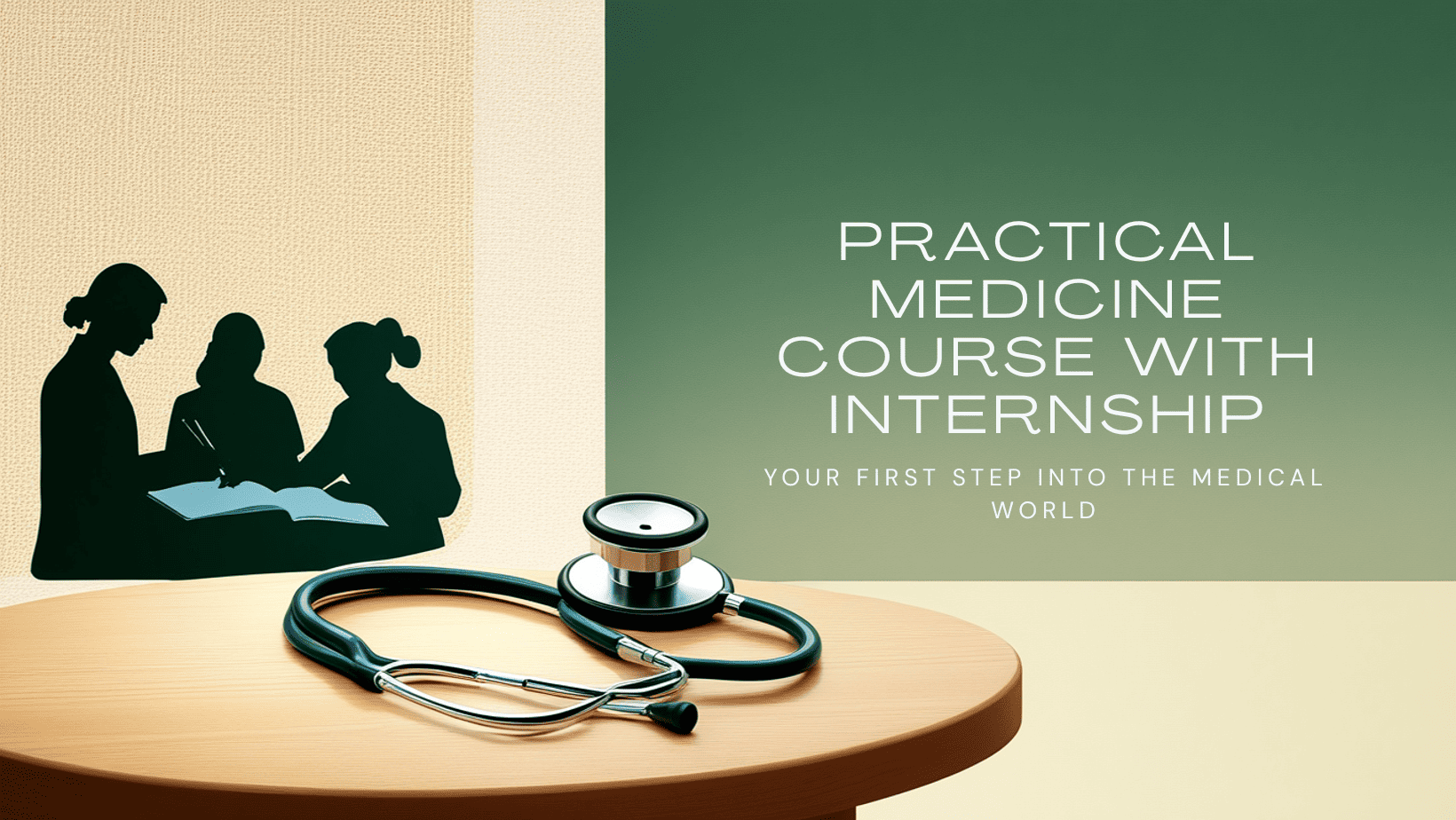

Choosing a career in medicine is a big decision—and it starts with the right kind of training. While theory is important, what really prepares you for a job in healthcare is hands-on experience. That’s exactly what the Practical Medicine Course with Internship at RML Academy offers. This course is designed for students who want to go beyond books and actually learn how things work in a real medical setting. With a well-balanced medicine course duration of 12 months, this program combines classroom learning with real-life training, so you’re not just learning—you’re doing.
Imagine walking into a hospital on your first day of work with zero idea of what to expect. Scary, right?
That’s why practical training matters so much. It gives you the confidence to:
At RML Academy, we believe students should be trained not just to qualify, but to actually work in the medical field. That’s what this course is all about.
This course covers everything you need to get started in a medical or diagnostic role. The medicine course duration is around one year, and during this time, you’ll learn both the theory and the practical side of medicine.
Here’s a quick look at what’s included:
All sessions are conducted by experienced professionals who understand what it’s like to work in the field. You’ll also practice with real-world case studies and practical demos.
This course includes an internship with RML Pathology or one of its partner healthcare centers. During this period, you’ll be on the ground, applying what you’ve learned in class to real situations.
Here’s what you’ll do during your internship:
The internship gives you valuable experience—and makes your resume stand out when applying for jobs or further studies.
This course is ideal for:
If you’re passionate about helping people and want to start your career in medicine without long waiting periods, this course is for you.
After completing the course and internship, you’ll be ready for various roles like:
You can also go on to pursue advanced courses in nursing, pathology, radiology, or other medical specializations. With both knowledge and experience, you’ll have a strong foundation to grow in the healthcare industry.
If you’re serious about a career in healthcare, there’s no better place to start than RML Academy. This Practical Medicine Course with Internship gives you the training, experience, and support you need to step confidently into the medical world.


Not everyone who completes 12th grade dreams of MBBS, and that’s perfectly fine. Medical courses after 12th without NEET open doors to equally fulfilling and fast-paced careers in healthcare. With the booming demand for diagnostic and paramedical services across India—and especially in Lucknow—medical courses after 12th without NEET offer students a chance to skip the NEET exam and still build a great future in medical science.
Here are some top job-oriented medical courses you can pursue right after 12th, without appearing for NEET:
Course | Overview |
DMLT (Diploma in Medical Lab Technology) | A fast-track, in-depth program in diagnostic lab techniques. RML Academy trains you on real lab equipment and NABL workflows. |
B.Sc. Medical Lab Technology | Expands on DMLT with deeper theory and practical exposure. Ideal for those aiming for supervisory or research roles. |
Radiology Technician | Learn X-ray, ECG, ultrasound techniques—critical skills needed in every hospital. |
Operation Theatre Technician | Become skilled in operating theater procedures, sterilization, and patient care during surgeries. |
Certificate in Laboratory Techniques | A compact course covering sample handling, microscopy, and basic diagnostics—great for quick entry into labs. |
Physiotherapy Technician | Assist in physiotherapy treatment plans and rehabilitation—perfect for helping patients recover. |
X-ray Technician | Specialize in diagnostic imaging without the long wait of NEET-based courses. |
Healthcare Management | Combine medical knowledge with administrative skills—learn to manage clinics, labs, and hospital departments. |
These medical diploma courses after 12th are designed to deliver high salary medical courses without NEET hurdles.
Graduates from these programs can quickly step into roles like:
These medical career options without NEET offer stability, growth potential, and attractive salaries. With healthcare constantly evolving, your skills will only become more valuable.
At RML Academy, we offer top-tier RML Academy medical programs tailored for real-world success:
Convenient, affordable batches – Flexible timings and easy-friendly fee plans, ideal for freshers and working students.
You don’t need NEET to build a fulfilling medical career. Choose from top medical courses after 12th without NEET at RML Academy and step confidently into the healthcare field.
📞 Call now to book a free counseling session:
+91‑7991602008
🌐 Apply online: www.rmlacademy.com
Kickstart your career in diagnostic labs, OT, imaging, physiotherapy, or healthcare management. We’re here to guide you—every step of the way!


In the rapidly evolving world of healthcare, lab technicians play a vital role behind the scenes—analysing samples, diagnosing diseases, and supporting patient care. In Lucknow and beyond, there’s an increasing demand for skilled lab professionals as diagnostics and pathology services expand. Whether you’re finishing your 10th or 12th grade, or already in healthcare, enrolling in top-tier laboratory courses can set you on a path toward a rewarding and in-demand career.
Graduates and paramedics can pursue advanced training or internships to boost career prospects.
A popular job‑oriented lab course, DMLT offers comprehensive training in clinical laboratory science. Students learn sample collection, testing procedures, equipment handling, and lab safety—making it one of the most reliable paths to starting a career as a lab technician.
Certificate Course in Laboratory Techniques
Perfect for those seeking short-term exposure, this certificate course in lab technology covers essential skills in sample processing, microscopy, and basic diagnostics. It’s an excellent starting point or addition alongside other studies.
B.Sc. in Medical Lab Technology
For students aiming higher, this degree-level program dives deep into medical diagnostics, instrumentation, and practical lab science. Graduates often advance to supervisory roles or specialized labs.
Short‑Term Pathology Technician Courses
Focused programs offer targeted training in areas like blood banking, histopathology, and microbiology. Great for those wanting to quickly enter the pathology training program space or update their credentials.
Internship‑Based Lab Training Programs
Hands-on experience is critical. Lab internship after 12th gives students real-world exposure to diagnostic lab workflows, under the supervision of professionals—bridging classroom knowledge with practical skills.
RML Academy lab courses stand out for their structured, modern approach:
Faculty & industry links: Expert trainers, many drawn from diagnostic centers or hospitals, guide learning and offer placements.
Real‑time Lab Training: Unlike institutes with only classroom or simulated lab setups, RML connects you with actual pathology labs.
Placement Assistance: RML has established recruitment channels. Final-year students get help with interviews and securing internships or jobs.
Real‑time Lab Training: Unlike institutes with only classroom or simulated lab setups, RML connects you with actual pathology labs.
Placement Assistance: RML has established recruitment channels. Final-year students get help with interviews and securing internships or jobs.
If you’re ready to start a fulfilling journey in clinical laboratory science, explore the best paramedical courses Lucknow has to offer at RML Academy:
Visit our campus or website to learn more about our DMLT course, certificate programs, and internships.
Call now: +91‑7991602008
RML Academy offers the most comprehensive laboratory courses in Lucknow—combining practical training, career support, and a trusted learning environment. Whether through our DMLT course in Lucknow, short-term clinical laboratory course, or lab internship after 12th, we prepare you to excel in medical diagnostics. Don’t wait—enrol now!
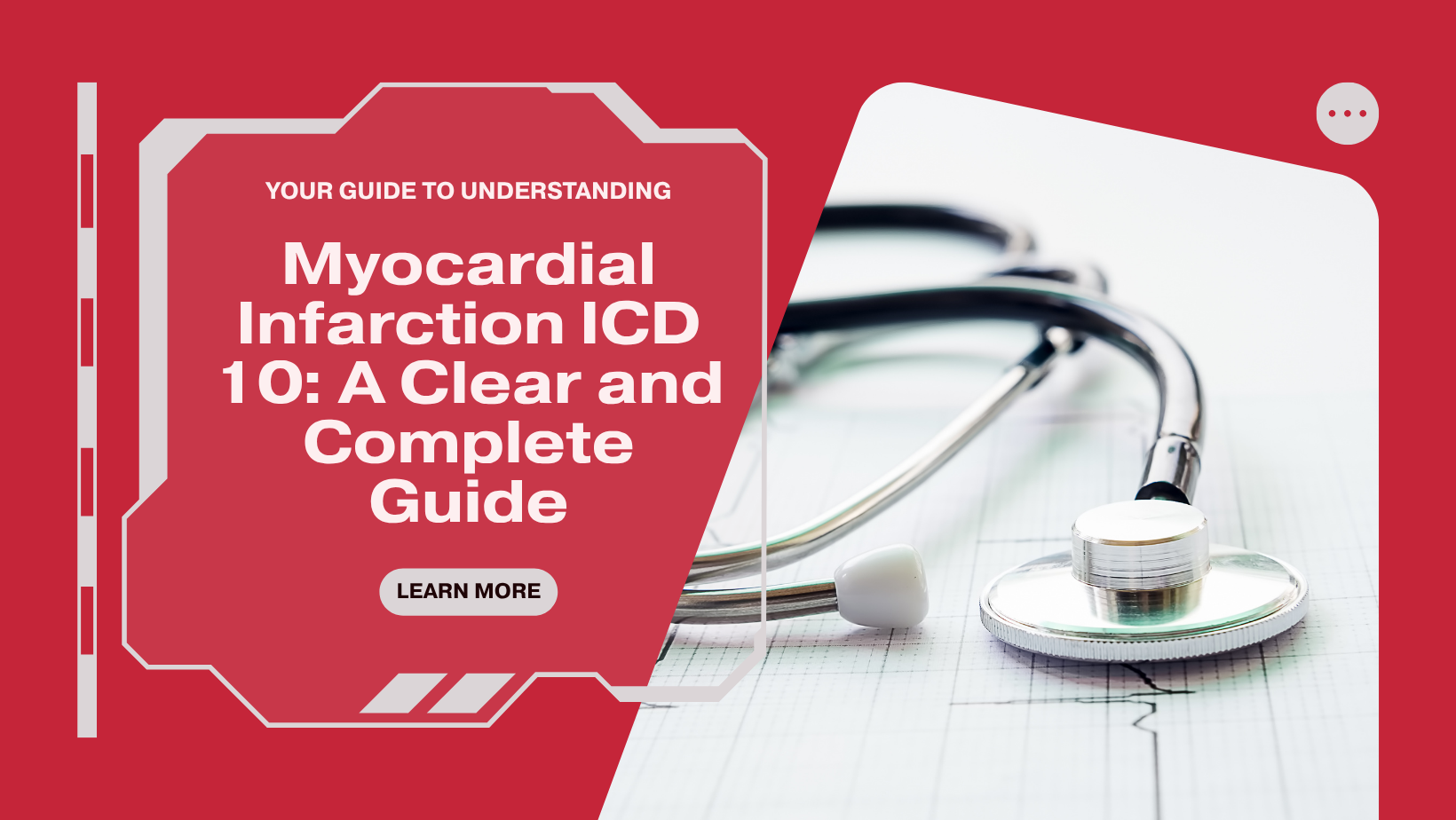
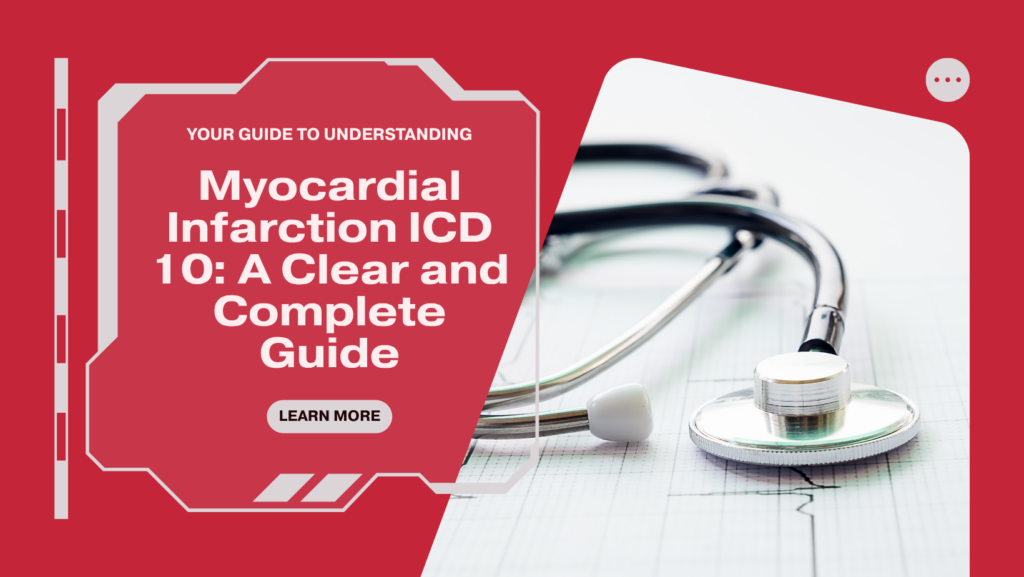
A heart attack is a life-altering event that comes without warning and demands immediate attention. In medical terms, it’s called a myocardial infarction. While the treatment begins the moment a patient reaches the hospital, another important aspect quietly takes place behind the scenes—medical coding. Doctors and hospitals use a global coding system known as ICD 10 (International Classification of Diseases, 10th Revision) to document diagnoses. When it comes to heart attacks, the myocardial infarction ICD 10 codes—such as I21.4 or I22.0—provide detailed information about the type, severity, and timing of the condition. These codes aren’t just technical labels; they tell a very specific story about a patient’s heart attack.
This article breaks down what myocardial infarction is, why ICD 10 codes matter, and how different types of heart attacks are categorized and recorded.
A myocardial infarction, commonly known as a heart attack, occurs when blood flow to the heart muscle is blocked, usually by a blood clot. Without oxygen, the affected part of the heart muscle begins to die.
This is a medical emergency—and every minute counts.
These factors either increase the chances of blockages forming in the arteries or make the heart more vulnerable to damage.
Doctors classify heart attacks into two main types based on how they appear on an ECG and how severe the blockage is:
Knowing which type of heart attack occurred is important not just for treatment but also for how the event is documented through ICD 10 coding.
ICD 10, short for International Classification of Diseases, 10th Revision, is a standardized coding system used worldwide to categorize diseases, injuries, and medical conditions. It helps hospitals, clinics, insurance companies, and public health organizations keep consistent records.
Every condition—from a common cold to a complex heart surgery—has an ICD 10 code. When it comes to heart attacks, using the right code ensures:
Consistent data for research and public health reporting
Heart attack codes fall under the I21 and I22 categories in the ICD 10 system.
These codes are used if a second heart attack occurs within 28 days of the first.
These codes aren’t just numbers—they give healthcare teams a detailed snapshot of what the patient experienced and how to proceed with care.
Correctly documenting a heart attack using ICD 10 codes is essential. Here’s why:
Inaccurate or vague coding can lead to billing issues, delayed care, or missed opportunities to understand disease patterns on a larger scale.
Symptoms may be more subtle in women, older adults, or people with diabetes.
Doctors use several methods to confirm a heart attack:
Treatment depends on the type of heart attack but may include:
Rehabilitation: Cardiac rehab programs and lifestyle changes for long-term recovery
A myocardial infarction is a serious condition that requires quick action, precise diagnosis, and accurate documentation. The ICD 10 code for myocardial infarction plays a behind-the-scenes role in making sure that patient care, billing, and long-term recordkeeping all happen seamlessly.
Whether you’re a healthcare professional, a medical student, or a patient trying to understand your medical report, knowing the basics of these codes can make things clearer. After all, it’s not just about numbers—it’s about telling the full story of what the patient went through and ensuring they get the care they deserve.


Finding out whether you’re pregnant can feel like one of the longest waits of your life. Whether you’re hoping for a positive result or feeling nervous about a possible surprise, one question is likely on your mind: “Maximum how many days to confirm pregnancy?”
It’s a common question—and an important one. Taking a test too early can lead to false negatives, unnecessary worry, or false hope. This article breaks down how early pregnancy can be detected, which tests are most accurate, and how RML Pathology helps you confirm pregnancy reliably and confidentially.
The key to confirming pregnancy lies in a hormone called hCG (human chorionic gonadotropin). Your body starts producing this hormone soon after a fertilized egg attaches to your uterus.
There are two main ways to detect hCG:
Here’s the short answer:
You can typically confirm pregnancy within 7 to 14 days after ovulation, or about a week after your missed period.
Let’s break it down:
If you want the earliest possible confirmation, a blood test is the most reliable option.
| Test Type | How It Works | When to Use | Accuracy |
| Urine Test | Detects hCG in urine | 1 week after missed period | ~97–99% (if done correctly) |
| Blood Test | Detects hCG in blood | 6–8 days after ovulation | Nearly 100% accurate |
Before you even take a test, your body might start dropping subtle hints. Some of the most common early signs of pregnancy include:
Remember, these symptoms can vary—and some women don’t feel anything at all. That’s why testing is the only way to be sure.
When it comes to something as important as confirming a pregnancy, you want accuracy, privacy, and support—all in one place. Here’s why RML Pathology is the preferred choice for thousands of women across Lucknow:
We’re NABL-accredited and known for maintaining the highest diagnostic standards.
Our quantitative hCG blood test gives you clear, reliable results—sometimes even before your missed period.
We understand how sensitive this moment is. Your test is handled with complete confidentiality, and results are delivered quickly.
Can’t step out? No worries—we offer home sample collection across Lucknow.
Waiting and wondering can be stressful. Thankfully, science has made it possible to confirm pregnancy fairly early—with the right test. If you’re asking, “Maximum how many days to confirm pregnancy?” the answer is usually between 7 and 14 days after ovulation, or a week after your missed period.
The sooner you know, the sooner you can take the next step—whether that means preparing for a baby or making an informed health decision.


If you’ve been trying to lose belly fat and it just won’t budge, you’re not alone. These 32 foods that burn belly fat fast and stubborn fat around your waistline is one of the most common health challenges today. And while workouts help, what you eat makes a big difference—sometimes even more than exercise.
The good news? You don’t have to starve or follow extreme diets. Nature has already given us plenty of foods that naturally help reduce belly fat, speed up your metabolism, and support a healthy body.
In this guide, we’ll explore 32 foods that burn belly fat fast — foods you can find at your local market and easily include in your everyday meals. And at RML Pathology, we believe smart food choices, paired with regular health checkups, can lead to long-term well-being and prevent future health problems.
Before we dive into the list, let’s quickly understand why belly fat builds up. Here are some common reasons:
But here’s the encouraging part — belly fat can be reduced naturally, without harsh diets or pills. The key is in what you put on your plate.
The foods listed below work by:
These foods aren’t just trendy “superfoods” — they’re real, natural ingredients that are rich in nutrients and easy to add to your meals.
Let’s break it down, one food at a time.
Eating smart is just one piece of the puzzle. Here are a few more ways to support your belly fat loss:
Stay consistent: Real results take time
There’s no magic pill to melt belly fat overnight. But when you fill your plate with the right foods — like these 32 fat-burning foods — you’re already on the path to better health.
At RML Pathology, we know that wellness isn’t just about looking fit — it’s about preventing disease, understanding your body, and making informed choices. That’s why we recommend regular health checkups, especially when starting a new diet or fitness plan. Your inner health matters just as much as your outer transformation.
Want to track how your new diet is affecting your health?

Get detailed insights into your metabolism, sugar levels, thyroid function, liver health, and more.
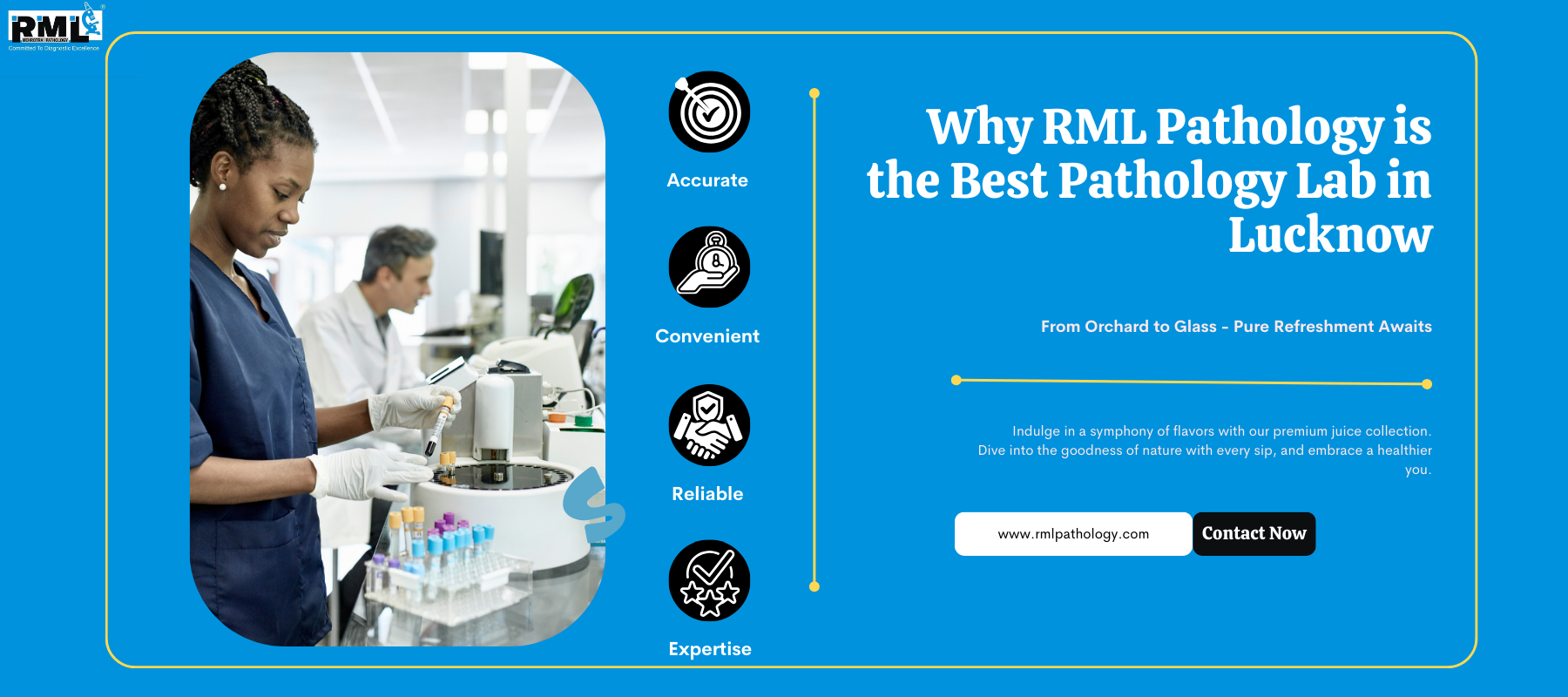
When it comes to your health, accurate and timely diagnostics are paramount. Going with the right pathology lab can make all the difference in your healthcare journey. In Lucknow, RML Pathology stands out as the best option for several compelling reasons.
RML Pathology provides a wide range of diagnostic services, ranging from routine blood tests to specialized screenings. Whether you need a complete blood count, thyroid function tests, or advanced genetic screenings, RML Pathology has you covered. Our extensive test menu ensures that all your diagnostic needs are met under one roof, saving you time and hassle.
We honor ourselves by using the latest diagnostic technology. Our lab employs cutting-edge equipment to ensure accurate and authentic test results. By engaging with advanced techniques like PCR (Polymerase Chain Reaction) and automated analyzers, we provide precise diagnostics that you can trust.
Our dedicated team of highly qualified pathologists, lab technicians, and support staff is committed to delivering exceptional care. With their expertise and meticulous attention to detail, every test at RML Pathology is conducted to the highest standards of accuracy and reliability. Our team is always available to discuss your results and answer any questions you may have.
Understanding the importance of convenience and safety, especially in today’s times, RML Pathology offers home sample collection services. Our trained professionals will visit your home to collect samples, ensuring minimal disruption to your daily routine. This service is particularly beneficial for the elderly, those with mobility issues, and individuals with busy schedules.
At RML Pathology, quality and accuracy are at the forefront of everything we do. We adhere to strict quality control measures and participate in external quality assurance programs to maintain the highest standards. Our lab is accredited and recognized for its excellence in diagnostic testing.
We believe in a patient-centric approach to healthcare. From the moment you step into our facility or schedule a home collection, you are our priority. Our friendly staff ensures a smooth and hassle-free experience, and we strive to deliver your results promptly. We also provide comprehensive consultations to help you understand your test results and the next steps in your healthcare journey.
At RML Pathology, we prioritize affordability without compromising on quality, ensuring accessible diagnostic services for all. We maintain transparency in our pricing, with no hidden charges, ensuring that you know exactly what you’re paying for.
We reinforce our standing as the best pathology lab in Lucknow through the positive feedback and testimonials from our patients. Many have praised our professionalism, accuracy, and the compassionate care they received. Word of mouth from satisfied patients continues to be our strongest endorsement.
Choosing RML Pathology means choosing excellence, reliability, and a partner in your health journey. Our comprehensive services, state-of-the-art technology, expert team, and dedicated to patient care make us the best pathology lab in Lucknow. Trust us for all your diagnostic requirements and experience the difference.
For more information or to book a test, visit our website at www.rmlpathology.com or contact us at +91-7991602001, +91-7991602002, +91-7991602003. Your health is our priority, and we are here to make sure you get the best possible care.
